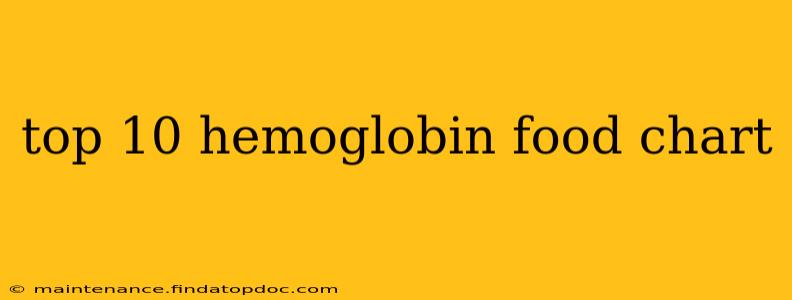Top 10 Hemoglobin-Boosting Foods: A Comprehensive Chart & Guide
Maintaining healthy hemoglobin levels is crucial for optimal health, as hemoglobin is the protein in red blood cells responsible for carrying oxygen throughout your body. Low hemoglobin, or anemia, can lead to fatigue, weakness, and other health problems. While medical advice should always be sought for diagnosis and treatment of anemia, incorporating these hemoglobin-boosting foods into your diet can significantly contribute to improving your overall health and well-being.
This article provides a comprehensive chart of the top 10 foods rich in nutrients that support hemoglobin production, followed by detailed explanations and answers to frequently asked questions.
Top 10 Hemoglobin-Boosting Foods Chart:
| Rank | Food | Key Nutrient(s) | Benefits |
|---|---|---|---|
| 1 | Spinach | Iron, Folate, Vitamin C | Excellent source of iron, vital for hemoglobin synthesis. Vitamin C enhances iron absorption. |
| 2 | Red Meat (Beef, Lamb) | Iron, Vitamin B12 | Heme iron, readily absorbed by the body. Also a good source of B12, crucial for red blood cell formation. |
| 3 | Lentils | Iron, Folate, Protein | Excellent source of plant-based iron and protein, supporting red blood cell production. |
| 4 | Chickpeas | Iron, Folate | Another great source of plant-based iron and folate, crucial for red blood cell formation. |
| 5 | Dark Leafy Greens (Kale, Collard Greens) | Iron, Vitamin K, Folate | Similar benefits to spinach, offering diverse micronutrients. |
| 6 | Beans (Kidney, Black) | Iron, Folate, Protein | Provide substantial amounts of iron and protein, vital for hemoglobin production. |
| 7 | Dried Apricots | Iron | Concentrated source of iron, offering a convenient way to boost intake. |
| 8 | Tofu | Iron | Plant-based source of iron, especially beneficial for vegetarians and vegans. |
| 9 | Fortified Cereals | Iron, Folate | Convenient way to increase iron and folate intake, especially useful for those with dietary restrictions. |
| 10 | Beetroot | Nitrates (indirectly boosts oxygen delivery) | While not a direct source of iron, nitrates in beetroot can improve blood flow and oxygen utilization. |
Understanding the Nutrients:
- Iron: The most crucial nutrient for hemoglobin production. There are two types: heme iron (found in animal products) and non-heme iron (found in plant-based foods). Heme iron is more readily absorbed.
- Folate (Vitamin B9): Essential for red blood cell formation and prevents megaloblastic anemia.
- Vitamin B12: Crucial for the maturation of red blood cells and prevents pernicious anemia.
- Vitamin C: Enhances the absorption of non-heme iron from plant-based foods.
- Protein: Provides the building blocks for hemoglobin synthesis.
What are the best foods to increase hemoglobin naturally?
The chart above highlights the top 10 foods, but the best foods for you will depend on your individual dietary needs and preferences. Prioritizing a diverse diet rich in iron-rich foods, folate, vitamin B12, and vitamin C is key.
Which foods are high in iron for hemoglobin?
Red meat, lentils, spinach, chickpeas, beans, and dried apricots are excellent sources of iron, both heme and non-heme. Remember that Vitamin C helps the body absorb non-heme iron more effectively, so consider pairing these iron-rich foods with citrus fruits or vegetables.
What are some quick and easy ways to increase hemoglobin levels?
Incorporating iron-rich foods into your daily meals is the most effective way. A quick breakfast could include fortified cereal with berries. Lunch could feature a lentil soup or a salad with spinach and chickpeas. Dinner could include lean red meat or beans with vegetables.
What are the best fruits to increase hemoglobin?
While fruits aren't the primary source of iron, they contribute indirectly. Fruits rich in Vitamin C, like oranges, strawberries, and grapefruit, enhance the absorption of iron from other foods. Dried apricots are also a good source of iron itself.
How can I increase my hemoglobin levels quickly?
While there are no quick fixes, focusing on a balanced diet rich in the nutrients mentioned above and consulting with a healthcare professional is essential for effective and safe management. Relying solely on dietary changes may not be sufficient for severe anemia; medical intervention may be necessary.
Disclaimer: This information is for educational purposes only and does not constitute medical advice. Always consult with a healthcare professional before making any significant dietary changes, especially if you suspect you have anemia or other health concerns. They can accurately diagnose your condition and recommend appropriate treatment plans.
